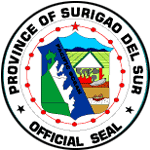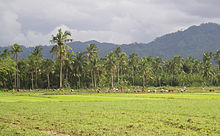Surigao del Sur
| Basic data | |
|---|---|
| Region : | Caraga |
| Capital : | Tandag City |
| Population : | 592,250 August 1, 2015 census
|
| Population density : | 120 inhabitants per km² |
| Area : | 4,932.70 km² |
| PSGC : | 166800000 |
| Governor : | Johnny Pimentel |
| structure | |
| - Highly urbanized cities | |
| - provincial cities | 2 |
| - municipalities | 17th |
| - Barangays | 309 |
| - electoral districts | 2 |
| Location of the province in the Philippines | |

|
|
Coordinates: 9 ° 0 ′ N , 126 ° 0 ′ E Surigao del Sur is the 56th province of the island state of the Philippines . It is located on the northeast coast of the island of Mindanao and politically belongs to the district of Caraga (Region XIII). The seat of the provincial government is in Tandag City . She belongs to the first income bracket of the provinces in the Philippines.
geography
Surigao del Sur is bounded in the west by the Diwata mountain range , which separates it from the provinces of Surigao del Norte in the north and from the provinces of Agusan del Norte and Agusan del Sur in the west. In the south it is bordered by the Davao Oriental province and in the east by the coast of the Philippine Sea , which in turn is part of the Pacific Ocean .
The province has a total area of 4932.70 km². This is 24.17% of the total land area of Caraga County and 4.46% of Mindanao Island .
Demographics and language
The population density is 119 inhabitants per km², relatively low by Filipino standards. Surigao is home to the Mamanwa and Manobo ethnic groups . Both ethnic groups were evangelized early on by the Spaniards.
Cebuano is the main dialect of the province and is spoken by 83% of the population. The dialect Surigaonon is the second most common language in this region with a share of 12%. Other minorities speak Filipino , Kamavo, Cantilangnon and Tagon-on. The English language is dominated by most residents.
The majority of the population belongs to the Roman Catholic religious community. A total of 420,087 or 83.83% of the population are Catholic. This is followed by the community of the Iglesia ni Cristo , which has 15,433 inhabitants or 3.08% of the population.
economy
About 45% of the total land area is cultivated and used for agriculture. The main crops grown in the province are rice , wheat , coconut , abacá , soybeans and coffee .
148 km² of Surigao del Sur is wetland and is largely used for fish farming. Here are shrimp , milkfish and shrimp bred for consumption in the province as well as for export.
Surigao del Sur is one of the few provinces in the country that are largely forested. A total of 211.11 km² are classified as forest area. Trees of the genus wing fruit take up a large part of the forest area. Some of the areas are covered with cloud forest in the mountains or mangroves on the coast. Economically used tree species are red and white Lauan, Mayapis and Tanguile, as well as rattan . However, precious woods such as the Narrabaum are on the list of threatened species today.
The province is also rich in minerals. These include copper , gold , chromium , cobalt , nickel and zinc in the case of metallic mineral resources , as well as limestone , cement , coal and feldspar , clay minerals and diatomaceous earth in the case of non-metallic deposits .
Political structure
Surigao del Sur is politically divided into 17 independently administered municipalities and two cities. The municipalities and cities are in turn subdivided into a total of 309 barangays (districts).
The province will continue to be divided into two congressional districts.
Cities
Communities
Origin of name
Before the arrival of the Spaniards, the Mamanua and Manobo peoples were the indigenous people of this area. Later immigrants came from the Visayas and pushed the ancestral residents back into the hinterland. The province's name is said to be derived from one of these immigrants, a man named Saliagao , who is said to have lived near an estuary. Due to a dialect-related modification, Saliagao became the name Surigao .
Another story tells that long ago some fishermen from the Visayas were driven into the Strait of Surigao by the strong current and landed somewhere on the coast of the province. When they went to one of the huts, the residents thought the fishermen wanted to occupy their houses and called Agaw , which means take away . Later, the immigrants added the prefix Suri and the name to denote the entire region.
history
The original inhabitants of the region consisted of a mixture of different races, such as the Mandaya, the Mamanua, the Mansaka and the Manobo. The ethnic groups were of Malay-Indonesian origin and had probably settled in northeast Mindanao centuries ago . It is believed that the migration of these early primitive nomads took place in different independent paths in different parts of the archipelago. It is also assumed that the northern islands of the country were first settled and that the northern coasts of Mindanao, i.e. the Surigao and Davao provinces, were later reached by using simple boats, the Bantus. Over time they dispersed and settled in groups and clans in various places along the coastal regions, where over the centuries they developed their own cultures, dialects and ways of life.
Although there are no exact dates or assignable places about their arrival, it is known that these people moved around as nomads and are considered to be the ancestors of today's ethnic group of the Mamanua and the Manobo, who are now in the wilderness of the Davao del province Norte on the border with Surigao have withdrawn. Your hiking route most likely came from the hinterland of Agusan, along the foot hills of the western and southern Surigao del Sur.
The area of Surigao was a single large province under the rule of the Spanish colonial power, which also included the administrative area of Agusan. This headquarters includes both the islands in the east and the northern region of Davao. The capital and the administrative seat was in the municipality of Caraga , whereupon the Spaniards referred to the inhabitants as Caragas.
In 1901, Agusan became a subordinate province of Surigao under American rule, and in 1907 Agusan was made an independent province.
On June 19, 1960 , the large province of Surigao was divided into the independent provinces of Surigao del Sur and Surigao del Norte with effect from Republic Act No. 2786 . Surigao del Sur became the 56th province of the Philippines .
Originally Surigao del Sur consisted of a total of 13 communities. In the following years, six more were added and the municipality of Tandag was appointed the seat of the provincial government. On September 18, 2000 , one of these communities, Bislig , was raised to city status. On June 23, 2007, Tandag was named the second city within the province (a so-called Component City). The most important educational institution in the province is the Surigao del Sur State University , which was founded on February 22, 2010.
climate
The province falls under the second type of climate category in the Philippines and is characterized by year-round rainfall. The months of July to October are usually characterized by lower rainfall, with September being the driest month. On the other hand, the period between November and June is rainy, with January being the wettest month.
Attractions
- Cathedral in Tandag
- Church of San Agustin
- Kaliguan Festival in Cagwait
- Britania archipelago
- Tinuy-an waterfall near Bislig
- Enchanted River in Hinatuan
Colleges
Web links
- Surigao del Sur Provincial Profile at Philippine Provincial Profiles ( Memento from January 12, 2005 in the Internet Archive )
- More information about Agusan del Sur at the Agusan – Surigao Historical Archive ( Memento from October 17, 2002 in the Internet Archive )
- WOW Philippines Surigao del Sur
- NSCB statistics on the province of Surigao del Sur


